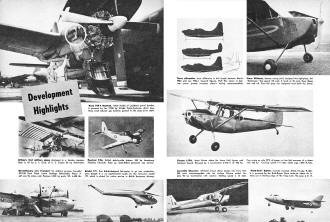|
It is kind of amazing that
as recently as 1950, aircraft manufacturers were still using radial engines on new
aircraft. This 1950 issue of Air Trails magazine reports on the Navy's
P2V-4 Neptune, the latest model of Lockheed's patrol bomber, which is powered by
two 3,200 horse power Wright Turbo-Cyclone radials. In-line engine formats are definitely
more streamlined, but from a maintenance perspective, being able to change out a
single cylinder rather than an servicing the entire block was definitely handier.
Having only ever ridden in one airplane having a radial engine (a
Ford Trimotor),
I can't say whether the vibration level was lower with a radial. Helicopters were
beginning to resemble more modern day models, rather than looking like experimental
platforms. Fighter jets like this "Hush-Hush" fighter (British Hawker P.1801), powered
by a Rolls-Royce Nene turbo-jet, were rapidly replacing propeller planes. The wingspan
was only 31 feet.
Development Highlights
 Navy P2V-4 Neptune, latest model of Lockheed
patrol bomber, is powered by two 3,200 hp Wright Turbo-Cyclones, which have three
small exhaust gas turbines geared to the prop drive shaft. Navy P2V-4 Neptune, latest model of Lockheed
patrol bomber, is powered by two 3,200 hp Wright Turbo-Cyclones, which have three
small exhaust gas turbines geared to the prop drive shaft.
Britain's first military plane displayed in a London museum. Built in '07 by
S. F. Cody of U. S. Engine 50 hp Antoinette.
Percival P.56, British side-by-side, trainer. 420 hp Armstrong Siddeley Cheetah;
fixed l.g. Semi-skilled personnel can service.
Revolutionary new transport for military services, Fairchild XC-120 Pack Plane.
Lower fuselage detachable. Plane itself can fly minus pod. Engines 3,250 hp each.
Wt. 6,400 lbs.
Bristol 171, first British-designed helicopter, to go into production, even though
it is an experimental model for the twin-rotor model 173 which is slated for active
service in British European Airways.
Three silhouettes show difference in hull length between Martin PBM and new PBM-1
(second figure). Hull flap shown in bottom corner greatly increases plane's taxiing
maneuverability.
Steve Wittman, famous racing pilot, designed this lightplane, the "Buttercup."
Top speed 130 mph. It lands at 30 mph. Gear flexes fore and aft. Even the prop was
designed - and built - by Steve!
Cessna L-19A, latest liaison plane for Army field forces and National Guard.
Powered by a Continental 0-470-11 of 190 hp. Can cruise on only 29% of power, so
has fuel economy of a plane with 100 hp. Cruising speed 114 mph; climb over 1,000
ft./min.
Luscombe Observer, all-metal liaison plane design, has more than 500 parts interchangeable
with the civilian Silvaire model. Engine 90 hp Continental with injector. Stalling
speed is 35 mph.
"Hush-hush" fighter, recently unveiled, British Hawker P.1801. It is powered
by the Rolls-Royce Nene turbo-jet whose air intakes are in leading edge of the wing
roots. The span is 31 ft.
|



